 Back to Archaeological Sites
Back to Archaeological Sites
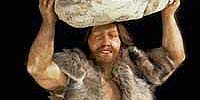 Mousterian (Neanderthal) Sites
Mousterian (Neanderthal) Sites
Central European Sites
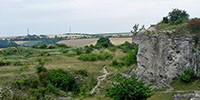 The Bohunician is an Initial Upper Palaeolithic culture, incorporating elements of the Mousterian with the lower Aurignacian. The term 'Bohunician' is derived from the word Bohunice, the name of a suburb in the western part of the city of Brno, where this specific industry was first investigated. The stone tools often were produced from Levallois blade cores with hard-hammer percussion and include many forms considered typical of Upper Paleolithic industries associated with modern humans (that is, end scrapers and simple burins), as well as Levallois points and side scrapers. Some assemblages also contain bifacial leaf-shaped points (more common in the northern sites).
The Bohunician is an Initial Upper Palaeolithic culture, incorporating elements of the Mousterian with the lower Aurignacian. The term 'Bohunician' is derived from the word Bohunice, the name of a suburb in the western part of the city of Brno, where this specific industry was first investigated. The stone tools often were produced from Levallois blade cores with hard-hammer percussion and include many forms considered typical of Upper Paleolithic industries associated with modern humans (that is, end scrapers and simple burins), as well as Levallois points and side scrapers. Some assemblages also contain bifacial leaf-shaped points (more common in the northern sites).
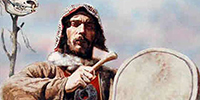 In 1891, when excavations for a sewerage system were taking place in Brno, Czech Republic, the skeleton of an old adult male was found covered by a mammoth scapula, in ochre stained sediment within the sandy deposits of a river terrace. Included in the grave were a now famous marionette made of mammoth ivory, as well as other grave goods, including a broken drum stick, rondelles shaped like vulvas, and more than 600 Dentalium fossil sea shells. He is believed to be a shaman, who overcame pain from congenital bone inflammation to become an important member of society.
In 1891, when excavations for a sewerage system were taking place in Brno, Czech Republic, the skeleton of an old adult male was found covered by a mammoth scapula, in ochre stained sediment within the sandy deposits of a river terrace. Included in the grave were a now famous marionette made of mammoth ivory, as well as other grave goods, including a broken drum stick, rondelles shaped like vulvas, and more than 600 Dentalium fossil sea shells. He is believed to be a shaman, who overcame pain from congenital bone inflammation to become an important member of society.
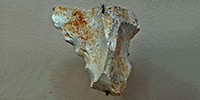 The Mousterian of Eastern Europe - Mousterian hand axes were found at Kadova u Mor, Krumlov, Určic u Prostějov and Lubná u Kroměříže in the Czech Republic, and Kůlna Cave in the Moravian Karst is an important site. The full range of Mousterian tools are found in this area, including tools with notches and teeth, of the type known as the Denticulate Mousterian.
The Mousterian of Eastern Europe - Mousterian hand axes were found at Kadova u Mor, Krumlov, Určic u Prostějov and Lubná u Kroměříže in the Czech Republic, and Kůlna Cave in the Moravian Karst is an important site. The full range of Mousterian tools are found in this area, including tools with notches and teeth, of the type known as the Denticulate Mousterian.
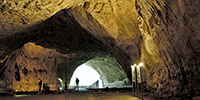 Kůlna Cave forms a massive tunnel on the eastern slope of the Sloupské Valley. The researches of the Anthropos Institute brought not only extensive collections of Middle Palaeolithic tools and at the same time the oldest evidence of the settlement of the Moravian Karst, but also the most numerous remains of Neanderthal man in the Czech Republic.
Kůlna Cave forms a massive tunnel on the eastern slope of the Sloupské Valley. The researches of the Anthropos Institute brought not only extensive collections of Middle Palaeolithic tools and at the same time the oldest evidence of the settlement of the Moravian Karst, but also the most numerous remains of Neanderthal man in the Czech Republic.
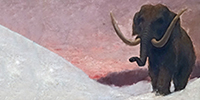 The complex of Gravettian stations near Milovice lies in a side valley without a view of the Dyje (Thaya) River, aside from the main settlement area, below Pálava. The stations are part of the complex including Pavlov and Dolní Věstonice. The site is notable for the huge amount of accumulated bones of mammoths for which the valley provided extremely suitable conditions for hunting.
The complex of Gravettian stations near Milovice lies in a side valley without a view of the Dyje (Thaya) River, aside from the main settlement area, below Pálava. The stations are part of the complex including Pavlov and Dolní Věstonice. The site is notable for the huge amount of accumulated bones of mammoths for which the valley provided extremely suitable conditions for hunting.
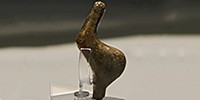 Pekarna Cave, Moravia, Czech Republic is famous for its stylised venus figure in the Gönnersdorf tradition, as well as several other engravings and art works.
Pekarna Cave, Moravia, Czech Republic is famous for its stylised venus figure in the Gönnersdorf tradition, as well as several other engravings and art works.
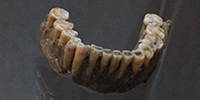 Švédův Stůl Cave is a short 'through cave' in a rock block (hence the name Swede's Table). Besides cave bears, hyenas and other animals inhabited the cave as well as Neanderthals 100 000 years ago. In the portal cave Švédův Stůl in the valley of the Hádacky brook, Karl Kubásek discovered part of the mandible of an adult Neanderthal a well as a few Mousterian artefacts in 1905. In 1953-55, when the soil was cleared from the entire front hall, B. Klíma finally found the mid-Palaeolithic artefacts.
Švédův Stůl Cave is a short 'through cave' in a rock block (hence the name Swede's Table). Besides cave bears, hyenas and other animals inhabited the cave as well as Neanderthals 100 000 years ago. In the portal cave Švédův Stůl in the valley of the Hádacky brook, Karl Kubásek discovered part of the mandible of an adult Neanderthal a well as a few Mousterian artefacts in 1905. In 1953-55, when the soil was cleared from the entire front hall, B. Klíma finally found the mid-Palaeolithic artefacts.
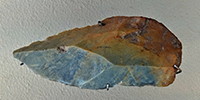 The Szeletian culture is an outgrowth of the Mousterian, similar to the Châtelperronian, an industry with elements of both the Mousterian and the Aurignacian. The Szeletian culture was widespread in what is now Hungary, Czechoslovakia, and southwestern Poland, and its influence can also be seen at a number of places in Romania and Bulgaria.
The Szeletian culture is an outgrowth of the Mousterian, similar to the Châtelperronian, an industry with elements of both the Mousterian and the Aurignacian. The Szeletian culture was widespread in what is now Hungary, Czechoslovakia, and southwestern Poland, and its influence can also be seen at a number of places in Romania and Bulgaria.
 Back to Archaeological Sites
Back to Archaeological Sites
 Mousterian (Neanderthal) Sites
Mousterian (Neanderthal) Sites
 Back to Archaeological Sites
Back to Archaeological Sites
 Mousterian (Neanderthal) Sites
Mousterian (Neanderthal) Sites Back to Archaeological Sites
Back to Archaeological Sites
 Mousterian (Neanderthal) Sites
Mousterian (Neanderthal) Sites Back to Archaeological Sites
Back to Archaeological Sites
 Mousterian (Neanderthal) Sites
Mousterian (Neanderthal) Sites Back to Archaeological Sites
Back to Archaeological Sites
 Mousterian (Neanderthal) Sites
Mousterian (Neanderthal) Sites The Bohunician is an Initial Upper Palaeolithic culture, incorporating elements of the Mousterian with the lower Aurignacian. The term 'Bohunician' is derived from the word Bohunice, the name of a suburb in the western part of the city of Brno, where this specific industry was first investigated. The stone tools often were produced from Levallois blade cores with hard-hammer percussion and include many forms considered typical of Upper Paleolithic industries associated with modern humans (that is, end scrapers and simple burins), as well as Levallois points and side scrapers. Some assemblages also contain bifacial leaf-shaped points (more common in the northern sites).
The Bohunician is an Initial Upper Palaeolithic culture, incorporating elements of the Mousterian with the lower Aurignacian. The term 'Bohunician' is derived from the word Bohunice, the name of a suburb in the western part of the city of Brno, where this specific industry was first investigated. The stone tools often were produced from Levallois blade cores with hard-hammer percussion and include many forms considered typical of Upper Paleolithic industries associated with modern humans (that is, end scrapers and simple burins), as well as Levallois points and side scrapers. Some assemblages also contain bifacial leaf-shaped points (more common in the northern sites).  In 1891, when excavations for a sewerage system were taking place in Brno, Czech Republic, the skeleton of an old adult male was found covered by a mammoth scapula, in ochre stained sediment within the sandy deposits of a river terrace. Included in the grave were a now famous marionette made of mammoth ivory, as well as other grave goods, including a broken drum stick, rondelles shaped like vulvas, and more than 600 Dentalium fossil sea shells. He is believed to be a shaman, who overcame pain from congenital bone inflammation to become an important member of society.
In 1891, when excavations for a sewerage system were taking place in Brno, Czech Republic, the skeleton of an old adult male was found covered by a mammoth scapula, in ochre stained sediment within the sandy deposits of a river terrace. Included in the grave were a now famous marionette made of mammoth ivory, as well as other grave goods, including a broken drum stick, rondelles shaped like vulvas, and more than 600 Dentalium fossil sea shells. He is believed to be a shaman, who overcame pain from congenital bone inflammation to become an important member of society.  The Mousterian of Eastern Europe - Mousterian hand axes were found at Kadova u Mor, Krumlov, Určic u Prostějov and Lubná u Kroměříže in the Czech Republic, and Kůlna Cave in the Moravian Karst is an important site. The full range of Mousterian tools are found in this area, including tools with notches and teeth, of the type known as the Denticulate Mousterian.
The Mousterian of Eastern Europe - Mousterian hand axes were found at Kadova u Mor, Krumlov, Určic u Prostějov and Lubná u Kroměříže in the Czech Republic, and Kůlna Cave in the Moravian Karst is an important site. The full range of Mousterian tools are found in this area, including tools with notches and teeth, of the type known as the Denticulate Mousterian. Kůlna Cave forms a massive tunnel on the eastern slope of the Sloupské Valley. The researches of the Anthropos Institute brought not only extensive collections of Middle Palaeolithic tools and at the same time the oldest evidence of the settlement of the Moravian Karst, but also the most numerous remains of Neanderthal man in the Czech Republic.
Kůlna Cave forms a massive tunnel on the eastern slope of the Sloupské Valley. The researches of the Anthropos Institute brought not only extensive collections of Middle Palaeolithic tools and at the same time the oldest evidence of the settlement of the Moravian Karst, but also the most numerous remains of Neanderthal man in the Czech Republic.  The complex of Gravettian stations near Milovice lies in a side valley without a view of the Dyje (Thaya) River, aside from the main settlement area, below Pálava. The stations are part of the complex including Pavlov and Dolní Věstonice. The site is notable for the huge amount of accumulated bones of mammoths for which the valley provided extremely suitable conditions for hunting.
The complex of Gravettian stations near Milovice lies in a side valley without a view of the Dyje (Thaya) River, aside from the main settlement area, below Pálava. The stations are part of the complex including Pavlov and Dolní Věstonice. The site is notable for the huge amount of accumulated bones of mammoths for which the valley provided extremely suitable conditions for hunting. Pekarna Cave, Moravia, Czech Republic is famous for its stylised venus figure in the Gönnersdorf tradition, as well as several other engravings and art works.
Pekarna Cave, Moravia, Czech Republic is famous for its stylised venus figure in the Gönnersdorf tradition, as well as several other engravings and art works.  Švédův Stůl Cave is a short 'through cave' in a rock block (hence the name Swede's Table). Besides cave bears, hyenas and other animals inhabited the cave as well as Neanderthals 100 000 years ago. In the portal cave Švédův Stůl in the valley of the Hádacky brook, Karl Kubásek discovered part of the mandible of an adult Neanderthal a well as a few Mousterian artefacts in 1905. In 1953-55, when the soil was cleared from the entire front hall, B. Klíma finally found the mid-Palaeolithic artefacts.
Švédův Stůl Cave is a short 'through cave' in a rock block (hence the name Swede's Table). Besides cave bears, hyenas and other animals inhabited the cave as well as Neanderthals 100 000 years ago. In the portal cave Švédův Stůl in the valley of the Hádacky brook, Karl Kubásek discovered part of the mandible of an adult Neanderthal a well as a few Mousterian artefacts in 1905. In 1953-55, when the soil was cleared from the entire front hall, B. Klíma finally found the mid-Palaeolithic artefacts. The Szeletian culture is an outgrowth of the Mousterian, similar to the Châtelperronian, an industry with elements of both the Mousterian and the Aurignacian. The Szeletian culture was widespread in what is now Hungary, Czechoslovakia, and southwestern Poland, and its influence can also be seen at a number of places in Romania and Bulgaria.
The Szeletian culture is an outgrowth of the Mousterian, similar to the Châtelperronian, an industry with elements of both the Mousterian and the Aurignacian. The Szeletian culture was widespread in what is now Hungary, Czechoslovakia, and southwestern Poland, and its influence can also be seen at a number of places in Romania and Bulgaria.